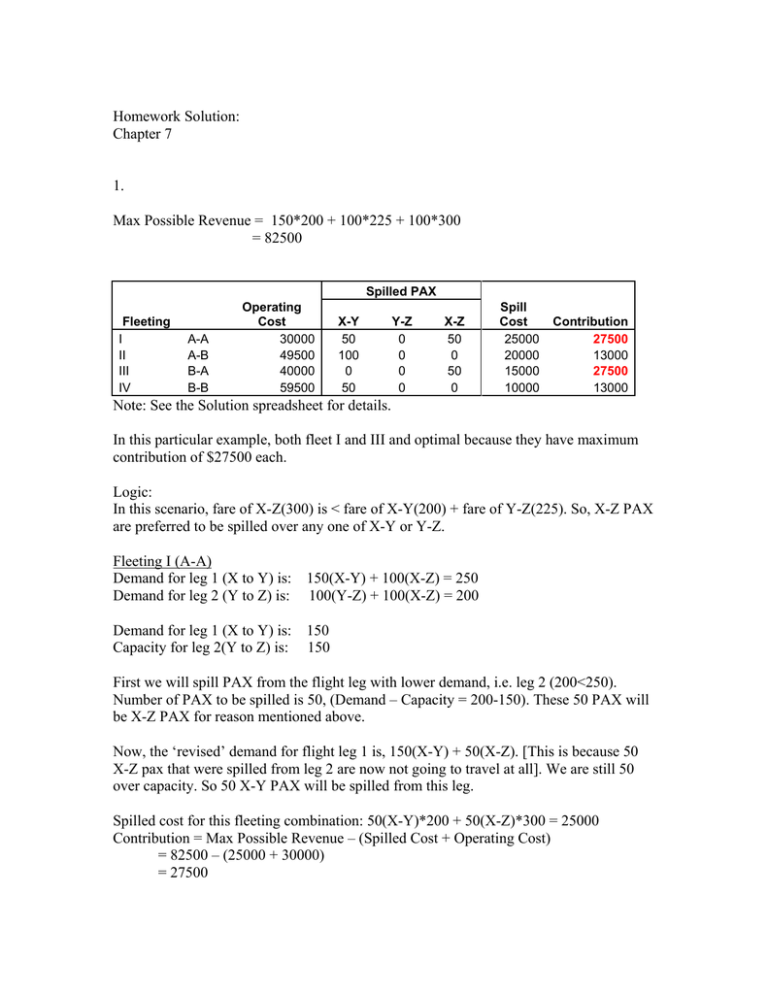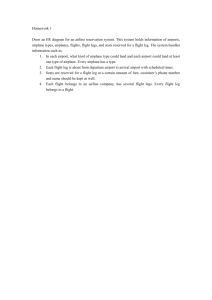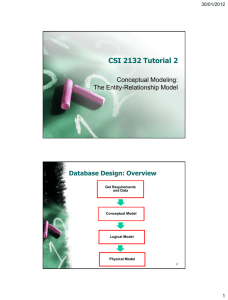Homework Solution: Chapter 7 1.
advertisement

Homework Solution:
Chapter 7
1.
Max Possible Revenue = 150*200 + 100*225 + 100*300
= 82500
Spilled PAX
Fleeting
I
II
III
IV
A-A
A-B
B-A
B-B
Operating
Cost
30000
49500
40000
59500
X-Y
50
100
0
50
Y-Z
0
0
0
0
X-Z
50
0
50
0
Spill
Cost
25000
20000
15000
10000
Contribution
27500
13000
27500
13000
Note: See the Solution spreadsheet for details.
In this particular example, both fleet I and III and optimal because they have maximum
contribution of $27500 each.
Logic:
In this scenario, fare of X-Z(300) is < fare of X-Y(200) + fare of Y-Z(225). So, X-Z PAX
are preferred to be spilled over any one of X-Y or Y-Z.
Fleeting I (A-A)
Demand for leg 1 (X to Y) is:
Demand for leg 2 (Y to Z) is:
150(X-Y) + 100(X-Z) = 250
100(Y-Z) + 100(X-Z) = 200
Demand for leg 1 (X to Y) is:
Capacity for leg 2(Y to Z) is:
150
150
First we will spill PAX from the flight leg with lower demand, i.e. leg 2 (200<250).
Number of PAX to be spilled is 50, (Demand – Capacity = 200-150). These 50 PAX will
be X-Z PAX for reason mentioned above.
Now, the ‘revised’ demand for flight leg 1 is, 150(X-Y) + 50(X-Z). [This is because 50
X-Z pax that were spilled from leg 2 are now not going to travel at all]. We are still 50
over capacity. So 50 X-Y PAX will be spilled from this leg.
Spilled cost for this fleeting combination: 50(X-Y)*200 + 50(X-Z)*300 = 25000
Contribution = Max Possible Revenue – (Spilled Cost + Operating Cost)
= 82500 – (25000 + 30000)
= 27500
Similar logic can be used to obtain the contribution of other fleeting combinations.
2.
(a)
L1 = flight 301, L2 = flight 102, L3 = flight 101, L4 = flight302, L5 = flight 201, L6 =
flight 202
I = {L1,L2,L3,L4,L5,L6}
k = {1,2}
G1 = G2 = {2,4,6,7,10,11,13,14,15}
i(6) * k(2) = 12 ; f binary
ground arcs (9)*k(2) = 18 ; y
12+18 = 30 variables
(b)
fki is 1 if fleet k is assigned to flight leg i. It is 0 otherwise
yka is number of aircraft of type k on the around arc a.
Nodes = {N1, N2, N3, N4, N5, N6, N7, N8, N9, N10, N11, N12}
Arcs = {1,2,3,4,5,6,7,8,9,10,11,12,13,14,15}
Flight Arcs = {1,3,5,8,9,12}
Ground Arcs = {2,4,6,7,10,11,13,14,15}
i = {L1,L2,L3,L4,L5,L6}
k = {1,2} ---{B737,A320}
M1 = M2 = 2
N1 = N2 = {N1, N2, N3, N4, N5, N6, N7, N8, N9, N10, N11, N12}
G1 = G2 = {2,4,6,7,10,11,13,14,15}
O(1,N1) = L1, O(1,N3) = L2, O(1,N5) = L3, O(1,N7) = L4, O(1, N8) = L5,
O(1,N11) = L6, O(1, N2|N4|N6|N9|N10|N12) = Null
O(2,N1) = L1, O(2,N3) = L2, O(2,N5) = L3, O(2,N7) = L4, O(2, N8) = L5,
O(2,N11) = L6, O(2, N2|N4|N6|N9|N10|N12) = Null
I(1,N2) = L1, I(1,N4) = L2, I(1,N6) = L3, I(1,N10) = L4, I(1, N9) = L5,
I(1,N12) = L6, I(1, N1|N3|N5|N7|N8|N11) = Null
I(2,N2) = L1, I(2,N4) = L2, I(2,N6) = L3, I(1,N10) = L4, I(2, N9) = L5,
I(2,N12) = L6, I(2, N1|N3|N5|N7|N8|N11) = Null
CG(1) = CG(2) = {13,14,15}
CL(1) = CL(2) = null
C(1,1) = 13664.7, C(2,1) = 13571.52, C(3,1) = 13608, C(4,1) = 13624, C(5,1) = 7200,
C(6,1) = 6000
C(2,1) = 13500, C(2,2) = 13000, C(2,3) = 13000, C(2,4) = 13500, C(2,5) = 9000, C(2,6)
= 9000
Node
+
_
N1
N2
N3
N4
N5
N6
N7
N8
N9
N10
N11
N12
0
2
0
4
6
7
14
0
10
11
15
13
15
14
13
2
4
0
6
7
0
10
11
0
(c ) MPL Code attached. Solution is:
SOLUTION RESULT
Optimal integer solution found
MIN Z
=
67379.5200
DECISION VARIABLES
VARIABLE f[i,k] :
i k
Activity
------------------------1 1
0.0000
1 2
1.0000
2 1
1.0000
2 2
0.0000
3 1
1.0000
3 2
0.0000
4 1
0.0000
4 2
1.0000
5 1
1.0000
5 2
0.0000
6 1
1.0000
6 2
0.0000
------------------------(d )
If A320s can’t fly to airport A. Then we will have to set all the f’s for flight legs
originating and terminating at airport A, i.e. L1,L4,L5 and L6 as 0. Mathematically this
would be equivalent to adding constraints:
f(i=1,k=2) = 0
f(i=4,k=2) = 0
f(i=5,k=2) = 0
f(i=6,k=2) = 0
MPL CODE:
TITLE
FAM_HWProblem;
INDEX
i
k
N
a
:= 1..6;
!6 flight legs
:= 1..2; !2 fleet types
:= 1..12;
!12 nodes
:= 1..15;
!15 arcs/edges
grA[a] := (2,4,6,7,10,11,13,14,15);!ground Arcs for A's network
grB[a] := grA;
flA[a] := (1,3,5,8,9,12);! flight Arcs for A's(and B's) network
flB[a] := flA;
N1[N] := N; ! All the nodes in A's network
N2[N] := N;
CL
CL1
CL2
:= (0); !CL and CG as defined on Pg 190 last paragraph
:= CL;
:= CL;
CG[a] := (13,14,15);
CG1 := CG;
CG2 := CG;
DATA
nPlus[N] := (0,2,0,4,6,7,14,0,10,11,15,13);
nMinus[N] := (15,14,13,2,4,0,6,7,0,10,11,0);
M[k] := (2,2); !total # of aircrafts of each type in inventory
O[k,N] := (1,0,2,0,3,0,4,5,0,0,6,0,
1,0,2,0,3,0,4,5,0,0,6,0);
I[k,N] := (0,1,0,2,0,3,0,0,5,4,0,6,
0,1,0,2,0,3,0,0,5,4,0,6);
c[i,k] := (13664.7,13500, 13571.52,13000, 13608,13000, 13624,13500,
7200,9000, 6000,9000);
BINARY VARIABLES
f[i,k]; ! 1 if fight leg i is serviced by fleet type k
VARIABLES
y[a,k]; ! # of aircraft of type k on ground arc a
MODEL
Min Z = SUM(i,k:c*f);
SUBJECT TO
cover[i]: SUM(k:f) = 1;
bal[N,k]: y[a:=nPlus[N],k] - y[a:=nMinus[N],k] + SUM(i=O:f) - SUM(i=I:f) = 0;
cp[k,CG,CL]: SUM(a=CG:y) + SUM(i=CL:f) <=M;
END





